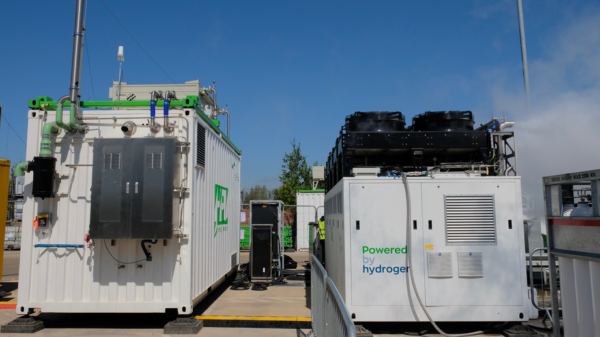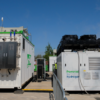In its Sixth Report this year, the United Nations Intergovernmental Panel on Climate Change (IPCC) said that a certain amount of global warming is irreversible. Within the next two decades, global temperatures will likely rise 1.5 Celsius. That’s more wildfires, reducing polar ice caps and more erratic weather.
Here are a handful of companies either actively fighting or reacting to climate change.
Tidewater Renewables guarantees two decades of revenue with RNG offtake agreement
Tidewater Renewables (TSX:LCFS) subsidiary Rimrock Renewables entered into a twenty-year long offtake agreement with FortisBC Energy.
FortisBC anticipates buying 525,000 gigajoules (GJ) of renewable natural gas (RNG) from a new Rng facility in Foothills County near High River, Alberta.
“On behalf of the entire team at Tidewater Renewables, I want to congratulate our partners at FortisBC for their leadership in climate action and look forward to working together to build a lower carbon future. The 20-year Offtake Agreement by FortisBC marks a significant milestone for the RNG Facility and enhances the economic certainty of the project,” said Joel McLeod, executive chairman and CEO.
The deal includes FortisBC’s annual purchase, which spells out guaranteed revenue for the project’s revenue generation. When it’s finished the RNG facility will be able to convert organic waste into enough energy to power over 5,800 homes in BC.
What makes this deal a little extra is that RNG is different from conventional natural gas.
First off, it’s produced in a different manner than conventional natural gas. It’s derived primarily from biogas, which is produced from decomposing organic waste from landfills and agricultural waste. Biogas is captured and cleaned to make RNG, which is called called biomethane and is 100 per cent carbon neutral. It’s possible to distribute gas via the existing grid and use in appliances by increasing the concentration of methane to a similar level as natural gas.
“One of the many ways we’re working to reduce greenhouse gas emissions is by increasing the amount of renewable and low carbon gases, like RNG, in our systems. And it is with agreements like these, with dedicated RNG suppliers such as Tidewater Renewables, that we can make commitments to reducing greenhouse gas emissions in our system and for our customers,” said David Bennett, director of renewable gas and low carbon fuels at FortisBC.
The agreement is still subject to regulatory approval by the British Columbia Utilities Commission, and a decision is anticipated by Q1 2023. Tidewater expects to turn on the pipes by the first half of 2024.
Maxeon Solar Technologies adds electric vehicle charging to its climate change fighting arsenal
Maxeon Solar Technologies (NASDAQ:MAXN) partnered with electric vehicle charging solution provider, Sun Charge, to incorporate Star Charge EV charging products as part of Maxeon’s SunPower One home energy solution.
This is the latest development by Maxeon to expand its SunPower One program. The program includes clean energy products and services that work with Maxeon’s solar panels.
“Maxeon Solar Technologies has led the solar panel manufacturing industry in areas such as panel reliability and longevity, unleashing greater value for customers. Building on this, we’re thrilled to see Maxeon taking an innovative approach to improve the experience customers can have with solar energy. We are confident this partnership will help to facilitate the uptake of electric vehicles in parallel with solar panels and have an overall positive impact on the world,” said Toni Cheng, CEO of Star Charge Europe.
Read more: The Mugglehead alternative energy roundup
Read more: California extends nuclear facility permit for five more years
Maxeon is headquartered in Singapore where it designs and manufactures Maxeon and Sunpower brand solar panels. It has since sold products in over 100 countries under the SunPower brand in certain countries outside the United States. It sports an intellectual property portfolio of over 1,000 patents and two best-in-class solar panel product lines.
“At Maxeon, we are delighted to continue building out our SunPower One home energy management experience thanks to partnerships with category leaders like Star Charge, ensuring we deliver on our promise of Powering Positive Change. Maxeon’s SunPower One makes clean energy adoption simpler through a fully integrated suite of products that allows consumers to take control of their domestic energy production and consumption, enabling financial and carbon savings. By educating and empowering homeowners with respect to the energy they create and consume, we aim to support and accelerate the global energy transition,” said Mark Babcock, interim CEO of Maxeon Solar Technologies.
The combination connects Star Charge’s research and development expertise for EV charging tech with Maxeon’s clean energy technology. It gives Maxeon the opportunity to enhance the homeowner benefits of solar production and consumption by adding EV charging management.
Bp expands climate change options with bioenergy
BP (NYSE:BP) announced the acquisition of Archaea Energy, which produces renewable natural gas (RNG) in the United States. The acquisition will be for $3.3 billion in cash, as well as around $800 million in net debt.
Picking up Archaea will give BP a greater foothold into the US biogas industry, as well as bumping its ability to support its customers’ carbon neutrality goals and move its aim towards reducing the average carbon intensity of its products. BP aims to be carbon zero by 2050 or soon an interim carbon reduction goal of 5 per cent by 2025. It also aims to reduce emissions another 15-20 per cent by 2030.
BP intends to use bioenergy as one of the five strategic growth engines to push on through this decade. The company anticipates investing into its transition growth businesses to reach over 40 per cent of its total yearly capital expenses by 2025, with an intent to grow that to close to 50 per cent by 2030.
“Archaea is a fantastic fast-growing business, and bp will add distinctive value through our trading business and customer reach. It will accelerate our key bioenergy growth engine, creating a real leader in the biogas sector, and support our net zero ambition. And, importantly, we’re doing this while remaining focused on the disciplined execution of our financial frame. Investing with discipline into the energy transition, creating further value through integration – this is exactly what bp’s transformation into an integrated energy company is all about,” said Bernard Looney, BP’s CEO.
Archaea is RNG producer based in Houston, Texas. It produces and operates 50 RNG and landfill gas-to-energy facilities across the United States. The company pushes out around 6,000 barrels of oil equivalent a day in RNG. Its development pipeline includes over 80 projects. Earlier this year, Archaea announced a joint venture with Republic Services to develop another 40 RNG projects across the United States. The JV’s operation converts landfill gas into RNG, and the company will use RNG to displace and replace conventional natural gas.
Organic waste is the key component in RNG, which makes it better for the environment than normal natural gas.
Burning it means lower lifecycle greenhouse gas emissions. Projects like Archaea’s could theoretically be integrated with technology like carbon capture and storage to further reduce emissions.
Charbone Hydrogen continues green hydrogen expansion with aggressive M&A
Charbone Hydrogen (TSXV:CH) concluded final negotiations for a purchase and sale agreement between its subsidiary Charbone Corporation, and Northwoods Hydropower.
This acquisition is for Northwoods’ Wolf River Hydro 700 kilowatt hydropower plant in Shawano, Wisconsin. The terms of the agreement put the price of the acquisition at USD$700,000.
The acquisition closes by or before November 15, 2022, according to the terms and conditions.
Next up for negotiations include agreements for the Tower Kleber Limited Partnership and Black River Limited Partnerships. The anticipated close date is December 15, 2022. Collectively, these deals could produce 2,760 kilowatt of hydropower. These particular plants are each located in the Onaway region of Michigan. The company will seek financing independent of the Shawana deal for these.
“This acquisition is the first step in Charbone’s strategy to enter the Midwest. This hydropower plant is in the heart of the famous US “rust-belt” around the Great Lakes, where the green hydrogen we produce will be used both in steel production and, in the near future, for heavy mobility. Charbone’s strategy to produce, in part, its own renewable energy and procure locally from local utilities or from Independent Power Producers (IPP’s) gives Charbone not only a competitive advantage in pricing, but also provides us with leverage to negotiate better rates for the available renewable energies in those regions,” said Dave B Gagnon, chairman and CEO of Charbone.
Green hydrogen and climate change fighter
Charbone is a Canadian green hydrogen company. The company’s strategy right now involves developing modular and expandable hydrogen facilities. Hydrogen doesn’t travel well, though, so shipping it becomes problematic. So an important part of Charbone’s growth involves finding acquisitions like the ones its made recently. It’s been buying up hydropower plants in the United States and Canada to support its inexorable and incremental growth across the continent.
The company’s present expansion plans include the development and construction of modular and scalable green hydrogen facilities in Wisconsin and Michigan. The expected time of completion for these? The next few years. All plants have the space required for the facilities and have space required to boost capacities through automation of modernization. Also, they possess updated hydro turbines allowing Charbone USA to transmit its power to hydrogen producers in the Midwestern US.
The Northwoods management will be staying on to perform their duties after the acquisition. They will also be assisting Charbone’s engineering team in terms with modernization and automating projects at each of the plants.
The financing for the Wolf River acquisition is in part through a CAD$1.2 million private placement of 14 per cent secured convertible debentures set to mature on October 7, 2024. The debentures aren’t going alone, though. There’s also 3,000,000 common share purchase warrants at a strike price of CAD$0.60 for two years.
Ansys simulations provide a glimpse into a carbon-free future
ZeroAvia is using Ansys (NASDAQ:ANSS) simulation solutions to develop its new hydrogen-electric powertrain with the intention to reduce aircraft emissions.
This is integral to the climate change argument because hydrogen-electric propulsion tech can produce 90 per cent less emissions than jet fuel turbines. ZeroAvia’s prediction is that its powertrain will also bring economic benefits in terms of lower operating costs.
“Without Ansys, we would still be writing code for high-level application, which would have increased the development and verification. For system certification, we use Ansys simulation to support the critical aspects of hydrogen-electric engine design – including thermal, safety, certification, stress, fatigue, and lifting,” said Youcef Abdelli, chief technology officer and chief engineer of electric propulsion systems at ZeroAvia.
Ansys is into simulations and has been for over five decades. Ansys software has given companies across industries the chance to use simulations for prediction purposes. The company served multiple industries in that time. A few of these include sustainable transportation, advanced semiconductors with satellite systems and medical devices.
ZeroAvia is into finding sustainable innovations for aviation. It demonstrated the potential for zero-emission flight by flying the world’s largest hydrogen-electric power aircraft, a Piper Malibu. Engineers with the company used Ansys multiphysics simulations, including structural analysis, fluid dynamics, FSI electromagnetic and electromechanical analysis.
The ZeroAvia system runs on electricity generated by solar panel to run an air compression pump. Oxygen combines with hydrogen stored in an on-board tank and reacts with hydrogen in the fuel cell to produce electricity to power an electric airplane motor. The chemical process emits only water.
“Ansys simulation has long been used for aircraft control code, so we are excited to see that startup companies with new ideas like ZeroAvia are turning to Ansys to accelerate development of their hydrogen fuel cell aircraft. By reducing aviation emissions, their hydrogen-electric powertrains will support global efforts to halt climate change,” said Walt Hearn, vice president of global sales and customer excellence at Ansys.
The next step involves taking the simulation real. ZeroAvia intends to fly a retrofitted Dornier 228 aircraft to test its market-entry product. The airplane has a 600 kilowatt hydrogen-electric powertrain designed for 9-19 seat aircraft. Additionally, ZeroAvia is developing a 2-5 megawatt powertrain capable of a flying 40-80 seat aircraft for 2026. Ansys is behind the simulations.














